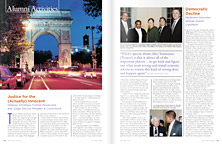Justice for the (Actually) Innocent
Defense Attorneys, Former Prosecutor, and Judge Discuss Mistakes in Convictions
Printer Friendly VersionThe Law Alumni Association’s Annual Fall Lecture drew more than 400 people, who ranged in age from high school students to an alumnus celebrating his 70th reunion. The lecture, “Guilty Until Proven Innocent: Is There Justice for the Wrongly Convicted, the Actually Innocent?” attracted a record number of alumni, who overflowed into a room with closed-circuit television. The panel comprised two defense attorneys, a former prosecutor, and a judge. Holly Maguigan (above center), a professor of clinical law at NYU School of Law, was the moderator.
Barry Scheck of Cardozo School of Law (second from right), a renowned defense attorney whose clients include Louise Woodward and O.J. Simpson, spoke about the Innocence Project, the organization he co-founded in 1992. The project focuses on exonerating prisoners with DNA test results. Scheck said that the FBI has found that in cases in which DNA evidence is made available, the main suspect is excluded 26 percent of the time. In state and local labs, the percentage is even higher—the main suspect is excluded about one-third of the time.
“If you translate this error rate into merely one-half of one percent, thousands of people will be exonerated,” Scheck said.
Peter Neufeld ’75 (far right), also of Cardozo School of Law, co-founded the Innocence Project with Scheck. “What’s special about Innocence is that it allows all of the important players—attorneys, judges, law enforcement—to go back and figure out what went wrong and install systemic reform to ensure this kind of wrong does not happen again,” he said.
Acting Justice Patricia Anne Williams (second from left), of the Supreme Court in Bronx County since 1989, said that justice is served through scientific discovery in a limited number of cases. Williams said that one of the primary reasons that innocent people end up in jail is because of mandatory sentences that give the innocent incentive to plead guilty and avoid a life sentence. She also pointed out that public defense attorneys in New York have not received a raise for more than 16 years, and blamed the media for being a major part of the problem.
“Maybe we have to make the media more responsive to a justice system, rather than selling papers,” she said. “The media is many times the worst enemy.”
Introducing yet another dimension to this issue, Zachary Carter ’75 (far left), formerly U.S. attorney for the Eastern District of New York and U.S. magistrate judge, who is now a litigation partner at the law firm of Dorsey and Whitney and co-chair of the firm’s white-collar crime group, blamed the jury system.
“One of the problems we face is an unreasonable confidence in the so-called miracle of the jury system,” he said. According to Carter, a Law School trustee, our country’s fervent belief in the jury system has caused us to overlook some blatant flaws, including the fact that so many people are wrongly convicted. He said that judges must stop confusing neutrality with passivity, because it is their responsibility to ensure that the process of trying a defendant is actually a quest for the truth.
Scheck closed the evening by summing up a sentiment shared by all the lecture panelists, and perhaps by the auditorium full of attendees as well: “It really is time to step up to the plate and do something about this problem of the wrongly convicted.”
The question of what, precisely, must be done was left open, but ample evidence, scientific and otherwise, was offered to prove that finding an answer is crucial.


 Multimedia
Multimedia